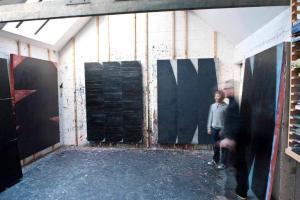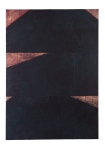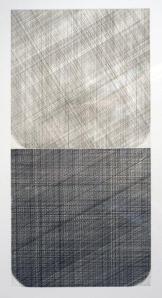 Charles Tyrrell is an artist living and working in the Beara Peninsula, a rural corner of the South West of Ireland. He is an abstract painter of critical acclaim and his work has been described as having more in common with the profound simplicity of Richard Serra’s sculptures and their exploration of gravity than with the issues of abstract painting1. Far removed from urban centres buzzing with the stuff of the contemporary art world, Tyrrell makes work of strength and relevance; his work reminding us that good painting [art] happens in the space between the painter and the work, independent of place.
Charles Tyrrell is an artist living and working in the Beara Peninsula, a rural corner of the South West of Ireland. He is an abstract painter of critical acclaim and his work has been described as having more in common with the profound simplicity of Richard Serra’s sculptures and their exploration of gravity than with the issues of abstract painting1. Far removed from urban centres buzzing with the stuff of the contemporary art world, Tyrrell makes work of strength and relevance; his work reminding us that good painting [art] happens in the space between the painter and the work, independent of place.
This year, Tyrrell has been showing a large body of work in a variety of venues across Ireland, with the final exhibit opening this month at the Royal Hibernian Academy in Dublin. To coincide with this leg of the tour, The Painting Imperative’s Roisín McGuigan asked Tyrrell about his practice.
Roisín McGuigan: I think we should start by introducing your work to the unfamiliar reader…
You have been exhibiting a new body of work this year, opening firstly at the Solstice Arts Centre, Navan, Co Meath, your home county, and moving on to the Crawford Art Gallery in Cork, your adopted county. The work is now on show at the Royal Hibernian Academy in Dublin; can you talk a bit about the works on show in this touring exhibition?
Charles Tyrrell: The core of the exhibition is nine large scale paintings, six are 210x150cm and three are diptychs measuring 160x310cm. Also in the exhibition are a number of smaller quieter paintings from 2009 as well as six etchings from 2008 which are what led me towards the new large canvases. In the Crawford show we gave these etchings the same space and emphasis as the large work and this I think made for a very dynamic hanging.
RMcG: It seems to me that process and the materiality of paint are central to the work you make. Would that be a fair assumption?
CT: Yes, the stuff of making. I put a lot of store on the process and allow the paintings build from my understanding of and relationship with the process. Having said that it’s not entirely process driven as I do carry strong ideas and images into the mix. Usually ideas and images that I feel create the right arena for things to happen, for notions to develop and expand and grow towards that final potent image. But, yes, ultimately my work does not come from a conceptual/ideas realm but is very material and physical and pragmatic… relying on an ever unfolding journey, a journey that can reach great intensity through concentration and alertness to the moment and materials.
RMcG: Where does your colour, or lack of colour, come from? Does colour matter in your work?
CT: While I’m not a high flying colourist, colour does matter greatly. I do tend towards low key colour endings but throughout the building process, intense pure colour can play an important role in driving the painting forward. I often play with colour as a way of marking time, a way of creating a dynamic internal dialogue, a way of teasing and testing ideas, teasing and testing myself, creating a lively and dynamic arena. An arena which will settle into a certain sense, a certain direction… usually slow down and tone down and finally lock into its absolute self.
RMcG: For me, the dark tones employed in your work cause your paintings to be both seductive and forbidding. Is this ambiguity intentional?
CT: I would not set out to be forbidding and I don’t have that reading for dark colours. Not at all. I just find huge depth and intensity in the dark tones. I’m glad that you find them seductive and if an ambiguity comes across too, that’s ok with me. I deal a lot with ambiguity; always steering clear of direct references and not wanting too particular a reading. I don’t want too neat an outcome for the viewer.
RMcG: How would you describe your process: Internal? Random? Structured? Ritualistic?
CT: An interesting line up there! I’ll take all four! All four have a place. Structured, certainly. I start with absolute structures; working within and around them. They are my base line. I would also say that my thinking in approaching painting is structured and strategic. A good degree of detachment. This structured, contrived, strategic approach is very important to me in defining and establishing the arena in which the type of painting I want can happen. As for Internal. I suppose all art making involves an internal probing, built as it is on personal impulses. I find the process always involves a demanding encounter with self. Random, yes, there’s always a randomness… random, intuitive impulses. I rely hugely on this throughout. That is at the core of what makes a painting tick. The stuff I cannot plan, the fingerprint. I would not think of my process as ritualistic but the notion of ritual interests me as I think artists always weave a lot of ritual in to the process of making… all different and personal. I know I do have such rituals as a way of finding my way in. This can be simple stuff…kind of naïve. But I think naivety can be an important ingredient in the process. Without naivety, a simple blind faith, art can become just a rational procedure. I often think that conceptual art at its most extreme can be just that… a neatly conclusive affair, somehow devoid of soul, mystery, revelation.
RMcG: The grids and divisions in your work provide you a base structure, do they keep you in check as you work through the painting, make you play by the rules, or do they encourage you to introduce the intuitive randomness?
CT: I have many forms of rules built into the process. I am quite proscriptive about proceedures and limitations. It is usually to do with stripping down possibilities on one level in order to increase possibilities on another level. It ties in with my belief that a painting can become much more than the sum of its parts and I believe that by being careful and selective about those parts the increased return can be greater. There is more room for the paintings potential to soar.
RMcG: You live in West Cork, a very rural part of the South West of Ireland, yet the only way it is associated with your work is through viewer interpretation. Does place matter in your work?
CT: Place, in the particular sense, is not of interest to me in my painting. The particular place in which I live and work is of great interest to me but I don’t want my work tied directly to that place. I suppose I want my painting to have a strong sense of place… the painting’s own place with its inbuilt, balanced, absolute totality. Having said that, I do often find a sense of my particular landscape in the work but my attitude to it is that it has come in of its own accord and I regard it as a welcome guest. On the matter of viewer participation I have no problems with full blown landscape readings being applied; I’m not proscribing that but am presenting paintings which hopefully offer many possible ways for the viewer to occupy.
RMcG: Your paintings certainly carry self-confidence; they know the place they inhabit.
But people absorb their context/environment in some way; so do you think perhaps the landscape finds a way into your work not as an influence but because it is an integral part of you, just as much as the paint is part of you?
CT: This landscape talk is a bit tricky as I can’t clearly say that landscape is not an influence. I suppose you could say I am not motivated to paint by the landscape… it’s never a starting point. I am motivated by the notion of paintings that are self-contained affairs; paintings that are internally driven, marching to their own beat. That said, I have to acknowledge the fact that the landscape plays a role. This is the dance I’m engaged in. Often it is a dance of avoiding the landscape…avoiding my minimalist urges and desires being hijacked. But I understand how it happens as I know I flirt with the landscape and this has consequences.
RMcG: What about other external stimuli in your practice, like film, music, literature?
CT: External influences are really art itself. I very strongly see myself as part of a continuum, part of a very big story, and I am inspired by all excellence achieved in that story.
RMcG: Who in that story inspires you, are there stand out figures you go to for sustenance?
CT: This is a constantly changing vista. I find that I am often more inspired by work that is outside the painting area that I’m involved with…whatever title you’d like to put on that! Work that is close to mine can more often confuse than inspire. In painting I’m inclined to look far back in the painting story for sustenance and that can shift and change depending on what is available to me first hand. Trips to Italy and encounters with the medieval masters there, always work. It is on the level of intensity, feeling, as well as technical mastery and the artifice so clearly celebrated, that I connect. The National Galleries of Dublin and London are always a great well to dip into. Contemporary sculpture inspires. Bold simple somewhat minimal work. Eduardo Chillida never fails. Ulrich Ruckriem was a big influence a while ago. I’ve always been interested in American minimalists like Sol Lewitt, Donald Judd, Carl Andre. I feel an affinity with the work of Irish sculptors John Gibbons and Michael Warren. And on and on. There are many roads I could go down where I find inspiration.
RMcG: The etchings exhibited in this touring show are an interesting counterpart to the heavy, dark canvases; where does printmaking fit into your overall practice? Does it influence the painting or does it stand alone?
CT: Printmaking is an occasional thing for me, a bit sporadic. I do not engage with it enough to have mastered the technical side so I always work with a master printmaker and over the years have been very well served. I like print. What is important to me is that it should not be an afterthought to the core activity but should be given a chance to develop within the print possibilities. I see too many prints by painters who seem to just try to replicate what they have achieved in painting. I was very happy that the six etchings in the recent exhibition were the impetus for a number of the large pieces and not a postscript.
RMcG: This respect for the medium, its individuality, is paramount in your painting too. How do you feel about the frequent discussions within contemporary visual arts practice around the validity of painting; as a painter, what’s your take on it?
CT: Frankly I don’t have a lot of time for the discussion, the academic rummaging. I’ll leave it to others. But, is it not a bit like saying singing is no longer relevant? I find it hard to imagine there being a consensus that painting is no longer relevant. That it should be dropped. It’s pretty fundamental stuff. Mark making. There is a lot of art practice that is far removed from painting but I don’t imagine it is trying to push painting off the stage. I think the stage has just got bigger. There’s room. One form should not be trying to outdo another. All should simply aim to push their form to the limits. I certainly am not going to jump ship because the art chattering classes have reasoned that what I do is no longer valid.
________________________________________________________________________________
Charles Tyrrell is a member of Aosdána, an affiliation of creative artists established by the Arts Council of Ireland in 1981 to honour those artists whose work has made an outstanding contribution to the arts in Ireland.
Charles Tyrrell, Selection from a New Series is on show at the Royal Hibernian Academy, Dublin until 21 December. www.royalhibernianacademy.ie www.charlestyrrell.ie
_________________________________________________________________________________
1 Patrick T. Murphy, New Works by Charles Tyrrell, Solstice Arts Centre and Crawford Art Gallery, 2011


